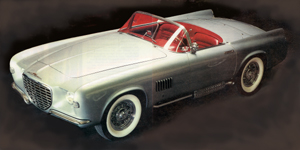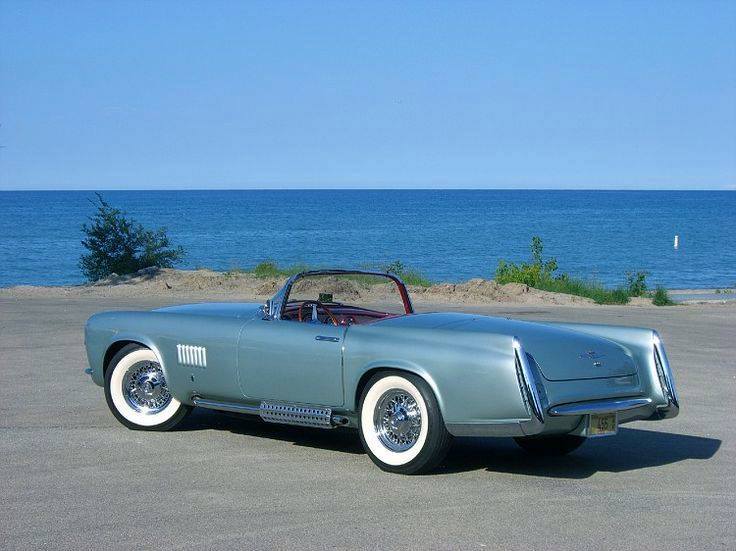Difference between revisions of "Chrysler Falcon"
| Line 1: | Line 1: | ||
| + | [[Image:Sponsor02.png|right|225px|]] <!-- Sponsor of this Wiki --> | ||
{{Template:Openx}} | {{Template:Openx}} | ||
| Line 5: | Line 6: | ||
{{Template:Underway}} | {{Template:Underway}} | ||
| − | |||
==Summary== | ==Summary== | ||
Revision as of 04:52, 2 April 2020

This Wiki is well underway, but can still use your help!
Please take a moment to add any small amount of information that you might have on this topic. It is through this type of collaboration that the MoparWiki will grow into being the Ultimate Mopar Infobase. Please fill in any missing information you know to be factual. Correct any you know to be inaccurate.
Summary
The 1955 Chrysler Falcon show car was an “Idea Car” of the Forward Look line of show cars. Conceived between 1952 & 1953 by Virgil Exner, it was completed in 1954 as a 1955-56 show car. The various design studies and development of this car can be seen in the photos taken of the styling model and in the handmade model presented to Virgil Exner by Ghia. Oddly enough this model is in the Exner collection at the Henry Ford Museum. It is interesting to note that Ford ended up using the Falcon name for its new compact sedan in 1960 and is still used to this day in Australia. Falcon sounds more like a sports car than a compact sedan. This sleek two seat “sport roadster” could have given Thunderbird and Corvette a run for their money.

Differences between design and engineering departments of Chrysler at the time negated a production run. The prototype cars were built with a 105” wheelbase and were Hemi powered. Some period literature claims that a 276 Hemi was used. The only known example has its original 331 Hemi. Features included a “Power Flite” automatic transmission, power brakes, power windows and bucket seats. The controls that operated the various systems were small levers centered on the lower dash. The simple grouping of four instruments, two in a pod over the steering column and the controls all make up for an elegant sporty interior. The convertible top could be completely stowed under a hatch that lifted up behind the seats.
Controversy
There has been a controversy over the years on exactly how many of these show cars were built. Some say three, some say one. Most point to the fact that several color variations of the car, red, silver and black, that were shown prove the existence of the three cars. It is also known that the one extant Falcon, owned by Joe Bortz, had been painted several colors in the past. The photographic and period documents point to the existence of at least two similar cars. Some of the original promotional photographs show one style with at least four distinct differences from the extant silver Falcon of Joe Bortz. The first being a different grill and nose treatment, (see above). The second difference is the spacing between the louvers on the front fenders wheel opening and the edge of the door. The third being the placement of the power window switches on the door and the fourth difference is in the cant of the windshield at the door post. It is highly unlikely that such drastic changes were made to just one car. Perhaps a document dated May 27, 1954 gives a clue. The letter was from Luigi Serge of Ghia to C.B. Thomas of Chrysler. The letter confirmed prices and orders for prototype vehicles to be built by Ghia. The first three items were as follows; 1) Model A-488 “Chrysler Sports Roadster”, $20,000 for the body and $2,500 for mechanical modifications. 2) Model A-488, same body as the first car at a 25% discount over the first car. 3) Model A-489 “DeSoto Sports Roadster”, $16,000 for the body and $15,000 for the monocoque frame. Three cars could have been produced. Only two can be confirmed by photographs. The Falcon was shown at various car shows between 1955 and 1956. Other appearances at the time found the Falcon in the public eye other than at a car show. A photograph from the Chrysler archives shows the Falcon at Watkins Glenn with Virgil Exner behind the wheel. In 1956 the Falcon made an appearance in the movie “Four Girls in Town”. With only a short time on the silver screen, this car showed off its design potential. A likeness could even be found in a set of cigarette package trading cards in Europe. Even today a small die-cast model is available to collectors.
It is unknown which of the three cars listed in the Ghia letter we can see today as Joe Bortz’s Falcon, but it is clear that the Falcon embodies simplicity of trim decoration and an emphasis on form that creates a timeless design that with few changes could be seen on the road today. Look at today’s Daimler-Chrysler products and you might just see a bit of the Falcon.
